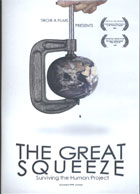
The Great Squeeze: Surviving the Human Project 2008
Distributed by Tiroir A Films Productions, Denver, CO.
Produced by Chistophe Fauchere and Joyce Johnson
Directed by Chistophe Fauchere
DVD, color, 67 min.
Sr. High - Adult
Economics, Environmental Studies, Political Science
Date Entered: 04/17/2009
Reviewed by Michael J. Coffta, Business Librarian, Bloomsburg University of PennsylvaniaThe Great Squeeze offers an enormous amount of scientific data on global climate change. The most notable aspect of this work is its exposition of the chain of events that follow from poor energy and labor choices. For example, the film explores melting glaciers in India, which may transform the Ganges into a seasonal river, flowing only in the rainy season. Wheat and rice production in India will then decrease, causing a greater demand for rice abroad, whose ecosystems are also suffering. In the last 50 years, Brazil has lost an amount of rainforest equal to the size of Texas. This has increased the load of carbon monoxide absorption on other vegetation and on the world’s oceans. It is this kind of “domino effect” demonstration that is the hallmark of this excellent work. There are multiple environmental consequences to every action.
With ample evidence, the audience sees the growing inertia of global climate change. It should be noted that this film also examines the potential political and economic outcomes of climate change. For example, a rise in ocean levels of ten feet could displace millions of people in Bangladesh. Not only will this cost a massive refugee problem, but will result in dramatically fewer crops, again increasing dependence on other crop producing countries with production problems of their own. Furthermore, if China’s population continues to grow at its present rate (with its increasing adoption of a near-American lifestyle), China alone will require two-thirds of the world’s total food production by 2030.
The audience receives a call to action with disquieting data on gasoline consumption, fresh water usage, projected increases in blights, insect infestation, and dead zones in oceans. From a production standpoint, The Great Squeeze delivers its powerful messages with headlines reporting deaths due to natural disasters, states of emergency and similar catastrophes. These headlines are strategically presented to demonstrate the trend under examination.
Offering alarmist content with a calm, credible delivery, this film challenges the world to use resources only at the rate at which those resources can be replenished. Another stirring feature of this work is its conspicuous use of the word “civilization,” suggesting that ours may fall just as others have. The value and cantor of this documentary cannot be understated.